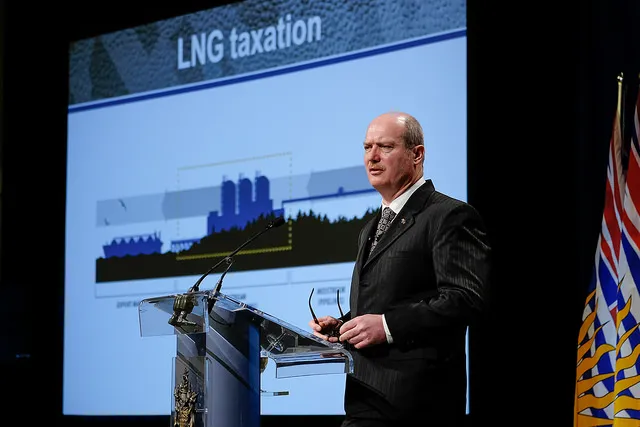Tuesday’s B.C. budget unveiled the first substantive information on the province’s promised liquefied natural gas (LNG) tax. While the budget did provide some welcome clarity, many questions remain unanswered — most importantly how much money will be collected from a given amount of exported LNG. Similar questions exist for the broader set of government fiscal policies that will apply to LNG. So, from liquefaction to fracking, here’s a look at some of the province’s bigger fiscal pieces that will apply to the LNG supply chain in B.C., if any projects do proceed.
The new LNG income tax
This new tax regime will be applied on the net proceeds (revenue minus expenses) of the operators of LNG terminals, where the gas is liquefied. The rationale for this approach was to avoid a) putting B.C. gas producers at a competitive disadvantage by taxing gas extraction, and b) creating a potential constitutional headache by taxing exports. The tax will be two-tiered with a lower rate of 1.5 per cent and a higher rate of up to seven per cent, which doesn’t apply until after the capital investment has been paid off.
The information in the budget provides some clarity on the general structure, but the details will be in flux until the fall session of the legislature. In advance of that session, the province needs to finalize the tax rates, and what capital costs, expenses and revenues are included in the tax calculations. All of that information then needs to be codified in legislation.
As mentioned, the information made available so far doesn’t help British Columbians understand how much revenue can be anticipated from a given quantity of exported LNG. The budget contains an illustration of possible revenues but it is simply an illustration of how the tax will work under specific assumptions; it’s not a reflection of actual revenue forecasts. The actual revenue will depend in large part on the costs to build and operate any project, and the selling price for LNG.
The carbon tax
The carbon tax is another important piece of the picture, one that is clearer and simpler. It applies to the combustion of fossil fuels in B.C., which will include the natural gas used to power compressors and other activities along the LNG supply chain. The carbon tax provides industry with an incentive to cut their carbon pollution: the less they pollute, the less carbon tax they have to pay.
Frozen at $30 per tonne for the next four years, the carbon tax will still provide a sizable incentive to reduce carbon pollution for an LNG terminal and other parts of the supply chain. At the current tax rate, the carbon pollution released by supplying and operating a two-train LNG terminal will yield a carbon tax bill as high as $200 million per year. Of course, the more that industry does to cut their carbon pollution, the lower that tax bill becomes.
The current $30 per tonne levy could also be higher by the time any LNG plants become operational, which won’t be until 2018 at the earliest. A higher carbon tax rate would be a stronger incentive to cut carbon and result in more revenue for government. Our perspective is that the carbon tax should continue to increase over time, but it is anyone’s guess as to how much it will go up over the lifetime of B.C.’s LNG industry.
Natural gas royalties
B.C. has an established royalty system that charges industry for the gas they produce. While this system undergoes periodic changes and updates, there is no indication that it is going to change because of a nascent LNG industry. According to the budget (Table 1.7), natural gas royalties will range from $441 to $580 million over the next three years. (For context, B.C.’s total revenue will be $45 billion next year).
Based on production volumes assumed in the budget (Table A5), that puts revenue at about $0.26 per gigajoule of gas produced. Working with the same two-train LNG terminal used to illustrate carbon tax revenue and the same average royalty rate, the royalties from supplying enough gas for export would be about $170 million per year — roughly one third of the royalties projected for the next few years. The average royalty rate will probably be different in 10 years time, but the province’s budget estimates only extend for three years.
Complementary climate change policies
The throne speech promised to bring forward additional environmental policy this year to meet the government’s commitment to produce the “cleanest LNG in the world.” While we don’t know the full details, part of that is expected to include complementary climate change policies for the LNG terminals. Offsets and a technology fund have been rumoured as possible approaches the government could take.
How much of an incentive those approaches add to the existing carbon tax incentive is still a big unknown, as is what the cost will be for industry and what other sorts of investments could result as spin-off benefits.
How the new LNG tax and climate policies complement the existing carbon tax and royalties, and what it means for the province’s “cleanest LNG” commitment, will be issues to watch in 2014.
Our calculations for carbon tax and royalty revenue estimates are available here.










